
Bodyline, also known as fast leg theory bowling, was a cricketing tactic devised by the English cricket team for their 1932–33 Ashes tour of Australia. It was designed to combat the extraordinary batting skill of Australia's leading batsman, Don Bradman. A bodyline delivery was one in which the cricket ball was bowled at pace, aimed at the body of the batsman in the expectation that when he defended himself with his bat, a resulting deflection could be caught by one of several fielders deliberately placed nearby on the leg side.
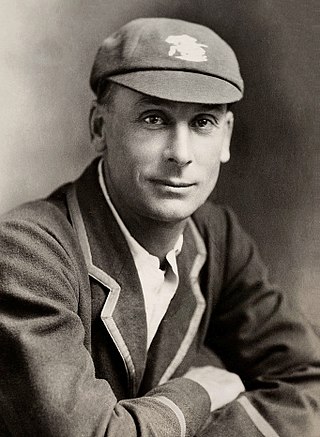
Sir John Berry Hobbs was an English professional cricketer who played for Surrey from 1905 to 1934 and for England in 61 Test matches between 1908 and 1930. Known as "The Master", he is widely regarded as one of the greatest batsmen in the history of cricket. He is the leading run-scorer and century-maker in first-class cricket, with 61,760 runs and 199 centuries. A right-handed batsman and an occasional right-arm medium pace bowler, Hobbs also excelled as a fielder, particularly in the position of cover point. Hobbs was named as one of the five Wisden Cricketers of the Century alongside Sir Donald Bradman, Sir Garfield Sobers, Shane Warne, and Sir Viv Richards.
David Edward John Frith is an English cricket writer and historian. Cricinfo describes him as "an author, historian, and founding editor of Wisden Cricket Monthly".
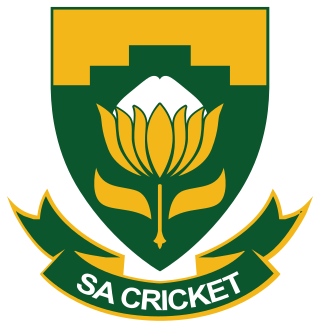
The South Africa men's national cricket team, also known as the Proteas, RSA, represents South Africa in men's international cricket and is administered by Cricket South Africa (CSA). South Africa is a full member of the International Cricket Council (ICC). Its nickname derives from South Africa's national flower, Protea cynaroides, commonly known as the "King Protea".

William Maldon Woodfull was an Australian cricketer of the 1920s and 1930s. He captained both Victoria and Australia, and was best known for his dignified and moral conduct during the tumultuous bodyline series in 1932–33. Trained as a schoolteacher, Woodfull was known for his benevolent attitude towards his players, and his patience and defensive technique as an opening batsman. Woodfull was not a flamboyant player, but was known for his calm, unruffled style and his reliability in difficult situations. His opening pairing with fellow Victorian Bill Ponsford for both his state and Australia remains one of the most successful in history. While not known for his tactical skills, Woodfull was widely admired by his players and observers for his sportsmanship and ability to mould a successful and loyal team through the strength of his character.

Archibald Campbell MacLaren was an English cricketer who captained the England cricket team at various times between 1898 and 1909. A right-handed batsman, he played 35 Test matches for England, as captain in 22 of those games, and led the team to defeat in four Ashes series against Australia. An amateur, MacLaren played first-class cricket for Lancashire, captaining that county for most of his career. As a batsman, MacLaren was one of the leading cricketers of his time and had a reputation as a fast-scoring stylist. In 1895, he scored 424 runs in an innings against Somerset which was the highest individual score in first-class cricket until 1923 and remained a record in English cricket until 1994. Opinions were divided over his captaincy. He was a deep thinker on the game and critics believed him to be tactically advanced, but his pessimism, clashes with the selectors and inability to get the best out of his players led most commentators to rate him a poor leader.

Sir Pelham Francis Warner,, affectionately and better known as Plum Warner or "the Grand Old Man" of English cricket, was a Test cricketer and cricket administrator.

Warwick Windridge Armstrong was an Australian cricketer who played 50 Test matches between 1902 and 1921. An all-rounder, he captained Australia in ten Test matches between 1920 and 1921, and was undefeated, winning eight Tests and drawing two. Armstrong was captain of the 1920–21 Australian team which defeated the touring English 5–0: one of only three teams to win an Ashes series in a whitewash. In a Test career interrupted by the First World War, he scored 2,863 runs at an average of 38.68, including six centuries, and took 87 wickets. He was inducted into the Australian Cricket Hall of Fame in 2000.

Clement "Clem" Hill was an Australian cricketer who played 49 Test matches as a specialist batsman between 1896 and 1912. He captained the Australian team in ten Tests, winning five and losing five. A prolific run scorer, Hill scored 3,412 runs in Test cricket—a world record at the time of his retirement—at an average of 39.21 per innings, including seven centuries. In 1902, Hill was the first batsman to make 1,000 Test runs in a calendar year, a feat that would not be repeated for 45 years. His innings of 365*, scored against New South Wales for South Australia in 1900–01, was a Sheffield Shield record for 27 years. The South Australian Cricket Association named a grandstand at the Adelaide Oval in his honour in 2003 and he was inducted into the Australian Cricket Hall of Fame in 2005. Hill is regarded as one of the best batsman of his era.
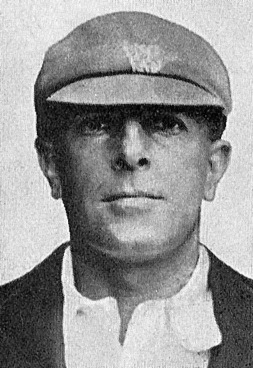
Charles George Macartney was an Australian cricketer who played in 35 Test matches between 1907 and 1926. He was known as "The Governor-General" in reference to his authoritative batting style and his flamboyant strokeplay, which drew comparisons with his close friend and role model Victor Trumper, regarded as one of the most elegant batsmen in cricketing history. Sir Donald Bradman—generally regarded as the greatest batsman in history—cited Macartney's dynamic batting as an inspiration in his cricket career.
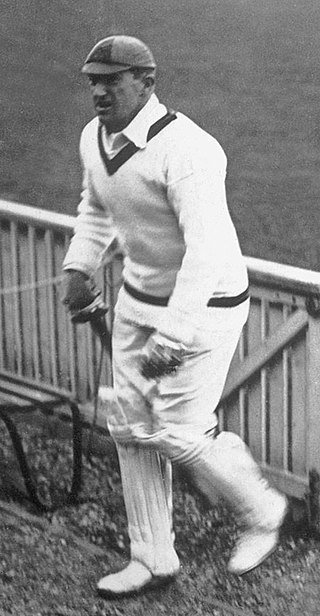
George Aubrey Faulkner was a South African cricketer who played 25 Test matches for South Africa and fought in both the Second Boer War and World War I. In cricket, he was an all-rounder who was among the best batsmen in the world at his peak and was one of the first leg spin bowlers to use the googly.

Dr. Herbert Vivian Hordern, also known as Ranji Hordern, was an Australian cricketer who played in seven Test matches between 1911 and 1912. He was the first major leg-spin and googly bowler to play for Australia. His nickname, "Ranji", came from his dark complexion, and is a reference to the famous Indian England test cricketer K S Ranjitsinhji. Hordern was a member of the Hordern family, well known as retailers in Sydney.
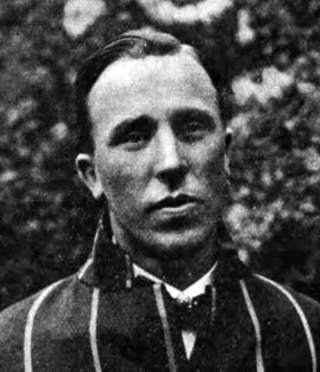
Sidney James Pegler was a South African cricketer. He emerged following the decline of their googly bowlers Vogler and Schwarz in the early 1910s.

The South African national cricket team toured England during the 1907 cricket season, playing three Tests and twenty four first-class matches. South Africa's quartet of bowlers, Reggie Schwarz, Aubrey Faulkner, Bert Vogler and Gordon White were praised for the quality of their googly bowling, and two of the four—Schwarz and Vogler—were recognised as Wisden Cricketers of the Year the following year.
This article describes the history of Australian cricket from the 1890–91 season until 1900.
This article describes the history of Australian cricket from the 1900–01 season until 1918.
The England cricket team toured South Africa under the auspices of the Marylebone Cricket Club from December 1905 to March 1906. There were five Test matches, and seven first-class games against South African provincial teams. While the team won a number of their first-class matches, they also lost several, and South Africa won the Test series 4 to 1.

Victor Thomas Trumper was an Australian cricketer known as the most stylish and versatile batsman of the Golden Age of cricket, capable of playing match-winning innings on wet wickets his contemporaries found unplayable. English cricket captain Archie MacLaren said of him, "Compared to Victor I was a cab-horse to a Derby winner". Trumper was also a key figure in the foundation of rugby league in Australia. His photograph taken by George Beldam in 1905 is often considered to be the greatest cricketing photograph ever taken.
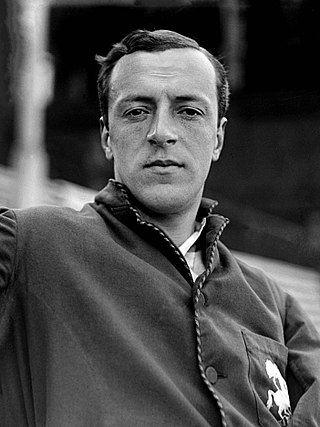
Bernard James Tindal Bosanquet was an English cricketer best known for inventing the googly, a delivery designed to deceive the batsman. When bowled, it appears to be a leg break, but after pitching the ball turns in the opposite direction to that which is expected, behaving as an off break instead. Bosanquet, who played first-class cricket for Middlesex between 1898 and 1919, appeared in seven Test matches for England as an all-rounder. He was chosen as a Wisden Cricketer of the Year in 1905.

Lord Hawke selected a cricket team of ten amateurs and two professional players to tour Australia and New Zealand from November 1902 until March 1903. After an opening game in San Francisco, the tour began of eighteen matches - seven of them considered first-class - in New Zealand followed by three further first-class games in Australia. Hawke's team was the first to tour Australasia with New Zealand as the primary destination and, as was the norm at the time, was privately run and funded. The Australian leg of the tour was a "profit making venture", however the games in New Zealand were scheduled at the behest of the New Zealand Cricket Board in order to raise the profile of cricket in the country. Two of them were against a New Zealand cricket team, before its international Test status. The inclusion of such games on the tour were considered "a sign that cricket in New Zealand was starting to be taken more seriously, and a move towards official international status was possible."















